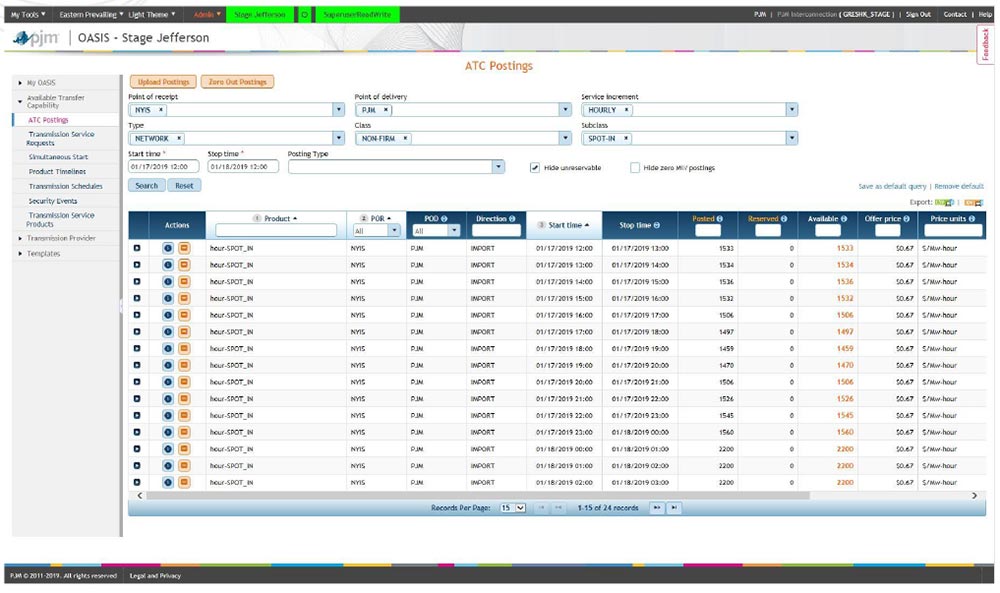Non-firm Transmission Service Pre-emption
PJM stakeholders on Thursday endorsed tariff language revisions to exclude the right of first refusal (ROFR) process from the RTO’s evaluation of non-firm transmission service requests.
Jeff McLaughlin, senior lead engineer in PJM’s transmission service department, reviewed the “quick fix” problem statement and issue charge to modify language in section 14.2 of the tariff related to pre-emption of non-firm transmission service at last week’s Operating Committee meeting.
McLaughlin said the quick fix was driven by compliance requirement changes within version 3.2 of the North American Energy Standards Board’s (NAESB) Business Practice Standards, which was adopted by FERC in January 2020 and becomes enforceable on Oct. 27. (See FERC Adopts NAESB Business, Communication Rules.)
An accelerated timeline was needed to make sure PJM’s proposed filing under Federal Power Act Section 205 receives a FERC response prior to the October enforcement date, McLaughlin said, and the RTO is proposing to review and vote on the issue charge and proposed solution after first read at the July 28 Markets and Reliability Committee and Members Committee meetings.
McLaughlin said that because an MC meeting is not scheduled for August, the vote needs to take place at all three committee meetings in July to allow for a 60-day window for a FERC ruling.
“This is an aggressive timeline we’re aiming for,” McLaughlin said. “This accelerated approach wasn’t something we took lightly.”
McLaughlin said the changes caused by the NAESB standards to the ROFR process could result in significant problems for PJM non-firm transmission service processes and OASIS customers. He said the changes create uncertainty for the most frequently used transmission products and could have detrimental impacts to the day-head and real-time energy markets.

PJM employs an automated engine for processing non-firm transmission service requests where customers receive instantaneous evaluations, McLaughlin said, but the pre-emption established by the NAESB standards introduces “significant delays” to the process. McLaughlin said the changes could result in more than two-hour delays for hourly challenger requests and more than 24-hour delays for daily challenger requests.
“It makes the process pretty unmanageable for us,” McLaughlin said.
McLaughlin said transmission service reservations that are procured in smaller increments, such as hourly and daily reservations, are at greatest risk of being pre-empted. He said most of PJM’s service requests fall into this high-risk category, with more than 90% of the 45,000 confirmed requests in 2020 consisting of hourly or daily service granted within 24 hours of the service start time.
“There’s just not a lot of time for the customers to react if they were to be pre-empted,” McLaughlin said.
PJM proposed using section 13.2 of the tariff that already contains language to exclude pre-emption from the evaluation of short-term firm transmission service. McLaughlin said the proposed revisions will extend similar language to section 14.2 of the tariff, excluding pre-emption from non-firm request evaluation.
McLaughlin said the tariff revision will prevent processing delays, minimize “unnecessary customer uncertainty for little benefit” and avoid impacts to the day-ahead and real-time markets.
Once the tariff changes are approved at the MRC and MC, McLaughlin said, PJM will make a Section 205 filing at FERC for a ruling before the October implementation of the NAESB standards.
“We felt this accelerated approach was in the best interest of PJM stakeholders,” McLaughlin said.
Manual 13 Changes Endorsed
Members unanimously endorsed updates to Manual 13: Emergency Operations, making minor changes to several sections.
Brian Oakes, of PJM’s dispatch department, reviewed the proposed changes to Manual 13. Oakes said most of the changes revolve around section 3.2: Conservative Operations, PJM’s emergency protocols to ensure the bulk electric system remains reliable during extreme events.
The manual changes resulted from discussions at the System Operations Subcommittee (SOS) after three declarations of conservative operations were made within the last year.
The first conservative operation declaration took place in August when Tropical Storm Isaias moved through the region and PJM was experiencing unrelated “server issues” at the same time. A second conservative operation declaration was made when a severe winter storm dumped record snowfall amounts on parts of the RTO on Dec. 16-17.
The most recent conservative operations declaration came on Jan. 6 during the attack on the U.S. Capitol. The only other occurrence in the last 10 years of a conservative operations declaration in PJM was September 2018 when Hurricane Florence moved through the region.
The manual language changes include authorizing PJM to conduct SOS conference calls to review and coordinate operations with members.
Other manual changes include updates to Attachment J: Disturbance Reporting. Oakes said the updates were done to reflect changes made by the U.S. Department of Energy to OE-417: Electric Emergency Incident and Disturbance Report, which was updated and renamed to DOE-417 and effective June 1.
The manual changes will receive a vote at the July MRC meeting and will take effect July 28 if endorsed.
COVID-19 Update
PJM is starting to look at allowing dispatch staff to move back and forth the between its two control centers.
Paul McGlynn of PJM provided his monthly update on operation plans in response to COVID-19, saying the RTO is “backing out” of some of the protocols put in place at the beginning of the pandemic.
At the start of the pandemic, McGlynn said, dispatch staff were split between the control centers in Valley Forge and Milford, Pa. McGlynn said the split increased the commute time for some of the staff.
This month, McGlynn said, dispatchers will once again enter a rotation between the two control centers. He said PJM is still maintaining social distancing protocols put in place at the control centers and will continue to follow those protocols “well into the fall.”
“Our intent is to move cautiously,” McGlynn said.
PJM is also starting a pilot program this week to introduce staff back on to its campuses. McGlynn said about 100 employees will return to the Valley Forge campus to test and provide feedback on some of the institutional changes, including temperature-screening kiosks and new technologies employed for meetings.
Paul Sotkiewicz of E-Cubed Policy Associates again inquired if PJM plans on mandating vaccines for its employees, especially for operations and planning staff. Sotkiewicz said he has heard reports about private organizations around the country mandating vaccines for their employees.
“Given the critical nature of PJM’s mission, it just seems like a no-brainer to me,” Sotkiewicz said.
McGlynn said PJM has not changed its policy and will not mandate vaccines for employees. He said staff have been encouraged to get vaccinated, but it will not be mandatory.
McGlynn said there were “many factors” that went into PJM’s decision not to mandate vaccinations.
“It’s a personal decision that people need to make about whether they choose to be vaccinated,” McGlynn said.
NRBTMG Sunset
Terri Esterly, senior lead engineer in PJM’s markets automation and quality assurance department, reviewed the status of the non-retail behind the meter generation (NRBTMG) business rules issue charge worked on at the OC in 2019.
Esterly said through stakeholder efforts on the issue, PJM updated Manual 13: Emergency Operations and Manual 14D: Generator Operational Requirements. The manual updates were endorsed at the September 2019 MRC meeting. (See “Non-retail BTM Generation Rules Endorsed,” PJM MRC/MC Briefs: Sept. 26, 2019.)
The manual updates clarified the reporting, netting and operational requirements of NRBTMG, Esterly said, and included establishing an annual reporting process to determine the total amount of NRBTMG in PJM.
Esterly said PJM’s Capacity Exchange system enhancements were released in 2020 to help facilitate the administration of NRBMTMG requirements.
Stakeholders completed the first three key work activities in the issue charge endorsed in 2019, Esterly said, but key work activity 4 was designed to be triggered only when the total amount of NRBTMG in PJM approaches a 3,000-MW cap.
The total amount of NRBTMG in PJM is posted each year in November, Esterly said, and the totals haven’t approached the 3,000-MW cap. The NRBTMG was 1,171.5 MW in 2019 and 1,186.4 MW in 2020.
PJM is proposing to sunset the NRBTMG business rules issue charge with the intent to bring it back and resume work when the 3,000-MW cap is reached. Esterly said an additional work scope in the issue may be considered in the future if appropriate.
Members will vote on sunsetting the issue charge at the August OC meeting.


